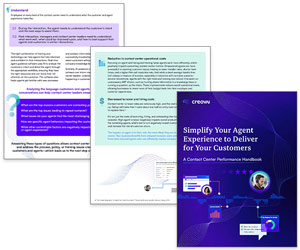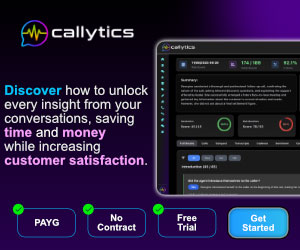In Paul Weald’s previous article he looked at the ‘case for change’ to uplift performance outcomes through frontline teams.
This uses the levers of performance management, coaching and QA to help agents and team leaders to engage with KPI reports, QA checks and performance data whilst operating remotely.
This is in the context of ‘doing more with less’ in response to the UK economic situation as we emerge from the pandemic.
In this second article, he focuses on the next level of detail – giving operational managers a checklist of factors to consider. He has broken these down into six key steps:
- KPI Measures – looking at the requirement for a balanced set of KPI measures and how narrowing the spread of performance across agent quartiles delivers a performance benefit across the operation.
- The Impact of Coaching – the role that team leaders play in delivering targeted coaching sessions, and recording the impact of these on agent performance.
- Using QA – all regulatory industries use quality scoring of calls as a means of ensuring agent compliance, but those same QA processes can also be used to identify examples of the ideal call, positively influencing agent behaviour.
- Choosing the Right Tools – by providing better data, insight and support, all individuals can become self-propelled and teams become self-managed.
- Target Setting for Reward and Recognition – using a peer group-based approach to identify, celebrate and learn from top performers, free from the bias of external factors.
- Making Performance Improvement Fun – the role of gamification in engaging agents and team leaders to deliver their best.
1. KPI Measures
Ever since the ACD was first invented some 25 years ago, contact centre managers have had performance data at their fingertips. Productivity metrics like calls answered, Average Handle Time and agent adherence to schedule have dominated performance reporting.
Just because you can measure something doesn’t mean that it is the right thing to do, so operations should focus on creating a balanced scorecard based on three key elements – People, Customer and Commercial.

For an operational team, a scorecard of clearly measurable KPIs across each of these elements would cover most business goals. However, one factor which is often overlooked is the impact of combined performance i.e. the ‘balanced’ in Balanced Scorecard.
We should consider the appropriate level of trade-offs that reflect the best overall outcome for customer experience and cost to serve.
In order to properly recognize top performers, focus on those agents who are delivering a ‘Good’ performance across all the people, customer and commercial KPIs, as they are contributing more value than someone who is delivering ‘Excellent’ commercial sales conversion at the expense of only ‘Average’ quality and customer satisfaction.
To find out recommended KPIs to track, read our article: 32 Contact Centre KPIs That You Need to Track (And Why!)
How Do You Understand the Spread of Performance?
Quartile analysis is one technique that allows you to measure the spread of performance across an agent population. This takes a league table of agent performance against different KPIs and splits then into four equally sized groups.
The first quartile includes the top-performing 25% of agents. The second quartile contains those within the 25-50% range, and this trend continues until the fourth quartile reaches the bottom 25%.
By analysing the behaviours of those within the upper quartiles, managers can identify best practices, which are proven to drive the best outcome for that KPI. These behaviours can then be coached across the other quartile groups to better deliver outcomes.
Typically, the gulf between top-quartile and bottom-quartile performers is much larger than most operations perceive, which inflates Cost to Serve due to the lowest performers often being less than half as productive as the highest.
By identifying the bottom-quartile performers, team leaders can better target and prioritize coaching sessions that will make the biggest difference to productivity outcomes.
2. The Impact of Coaching
Agents need also to understand the behaviours that lead to improved results.
Behavioural science tells us that coaching sessions need to have “immediate and certain” consequences. It’s the reason why it is so important for a team leader to praise an agent when they do something well, as this is positive ‘in the moment’ feedback.
Agents need also to understand the behaviours that lead to improved results. And when that certainty is lost, there is nothing new or additional to compel that behaviour any longer.
The scientists tell us that the absence of continual immediate feedback is usually the first and the biggest breakdown in an employee’s self-motivating behaviour.
When it comes to the messaging, team leaders who communicate specific inputs (e.g. promote a specific product with every customer in this scenario) rather than communicating output-related targets (e.g. just increase your sales conversion by 5%) will be more effective.
Continuous meaningful feedback – in small relevant bites – helps condition the heart and minds of staff.
Looking for ways to improve your coaching sessions? Read our article: 10 Great Ideas for Successful Call Centre Coaching Sessions
Delivering and Recording the Coaching Session
To hold a typical 1-2-1 performance review, a team leader often has to spend a lot of time in preparation – accessing reports, aggregating data, and deriving insight. Many businesses are encumbered with legacy systems and spreadsheet-based reporting that does little to support a team leader, which can often result in a lot of lost time.
The frequency of coaching sessions is also a key factor in supporting an agent to understand how to deliver better results.
Many agents who are performing well only need a monthly check-in to reinforce what they are doing well, whereas agents who are new in post and lower performers need more regular support – such as side-by-side coaching to reinforce learning.
Despite the best efforts of leaders, it is often not possible to provide the level of coaching and support due to time pressures.
In order to determine if the team leader is getting that balance right, then it is important for all coaching activities to be logged – both formal and informal. The point being that you should expect to see those coaching sessions contributing to improvements that agents are making.
By recording the timing and focus areas of sessions, and then overlaying this on a timeline of agent performance outcomes, then you should be able to see a correlation.

Agents need also to understand the behaviours that lead to improved results.
The best team leaders will do this intuitively, knowing where to focus their agent support and prioritizing their limited time resources appropriately, but what about your weaker team leaders?
This is where you need to prioritize their time focus by creating some workflow rules around the development activities that they need to deliver.
This will skew more support towards those agents with the most development needs, and less time towards the better agents.
It might also mean that you rebalance teams so that there is a fair mix of performers within the teams that are managed by the less experienced leaders.
3. Using QA
When done well, QA brings many additional benefits – assessing the performance of individuals and teams, highlighting coaching needs and positively influencing agent behaviour are all key examples.
Yet, QA initiatives often drown in their own process.
Plucking calls at random, filling in generic scorecards and feeding binary ‘pass/fail’ results back to agents is as far as some contact centre quality programmes go.
The follow-up activity too often focuses on poor performance, resulting in negative reinforcement at the expense of recognition and celebration of best practice.
Contact Babel reports that the greatest operational challenge to managing performance and quality is caused by QA users not having sufficient time to analyse and use data, with 38% of respondents strongly believing that their current performance and quality technology simply does not support what they would like to do.
What is required is more of a data-led approach, where operations map their QA processes – using customer satisfaction (CSAT) and Net Promoter Scores (NPS) – to customer outcome metrics. This ensures that agent quality scores are being assessed through the customer’s eyes.
Read our article Call Centre Quality Assurance: How to Create an Excellent QA Programme to find out how to develop your QA programme.
Scorecard Development
Where there’s limited correlation of quality scores with these customer-centric outcomes, then the quality scorecard will need to be rebuilt through call listening to pinpoint agent behaviours that drive the best customer reaction.
Once the scorecard has been redefined, quality analysts should calibrate it to remove subjectivity and ensure consistency across the business. This fosters a fair, open and honest QA culture around ‘what good looks like’.
What this means is that when assessments are fed back to advisors, team leaders can provide clear guidance as to how they performed versus what was expected of them.
As we all know, focusing on the positives is great for increasing advisor engagement, and a QA scorecard that is fair and balanced provides this reinforcement.
Another area where QA can add value is through outlier analysis. For example, a quality initiative that focuses on outliers in handling time i.e. long calls. The root causes might include contacts that were escalated to a supervisor, included multiple holds or contained transfers.
Understanding these features provides invaluable insight, which – if addressed – can stop similar behaviours and practices from recurring.
Once the scorecard has been redefined, quality analysts should calibrate it to remove subjectivity and ensure consistency across the business. This fosters a fair, open and honest QA culture around ‘what good looks like’.
QA tools can flag these outlier calls, enabling analysts to listen to them and learn what’s driving the issue. People, process or technology changes can then be made to improve customer service. This brings obvious financial benefits, while also safeguarding future CSAT.
And at the other end of the spectrum, when analysing a call that achieves a 100% quality score or features a great example of an agent going the extra mile, then flag that call and save it for later use. Such a call can then feature in agent training to give new recruits a clear-cut example of what good looks like.
And the recording may also be helpful in agent refresher training to highlight the new-found technique, so it becomes baked into behaviours across the entire agent population.
4. Choosing the Right Tools
During the pandemic, the flexibility, capability and cost of cloud-based technology and infrastructure has made it possible for contact centres to switch operating models quickly, removing the barriers of physical location as more agents started to work from home.
This was a powerful illustration of what technology can enable, and the same is true of the systems used for performance management, quality and coaching.
Increasingly, old ways of working are being discarded – manipulating performance, coaching and quality data in spreadsheets – in favour of a more integrated approach that recognizes that having access to information is an enabler, empowering agents and team leaders.
These requirements include:
- Individual Dashboards – providing the right data to the right people at the right time. Performance insight and data visualization tailored to individual roles, simplifying complex data and making it more consumable, so that the user can separate the signal from the noise.
- Performance Diagnostics – understanding how you are performing in relation to your historic results and in comparison with your peers. This enables a team leader to have meaningful goals and track progress against them. Adding the ability to view how agent peers are performing, and therefore to see what is possible, takes data insight to a far richer and more actionable level.
- Automated Repetitive Actions – building automation into the solution can save team leaders and QA teams time by reducing the amount of analysis needed gain insights or complete tasks. With smart configuration of the solution, a lot of the heavy lifting can be done automatically.
For set of key questions to consider when implementing performance management tools, read our article: A Checklist for Implementing… Performance Management Tools
Example Solutions
In terms of performance dashboard tools – like TMAC Coaching, miPerform and, to a lesser extent, the custom reporting modules of any of the contact centre CaaS tools – provide the following three capabilities:
- A Performance View – providing team and agent KPI reporting combining achievements and recognition
- A Coaching View – tracking events and coaching records with an emphasis on the performance uplift that resulted
- Behavioural Design – to deliver the next best coaching action to each advisor and team in a way designed with the end user in mind.
In terms of QA management, tools like EvaluAgent, ScoreBuddy and miPerform provide the following three capabilities:
- Facilitate the creation and customization of scorecards for evaluating customer interactions
- Offer tools for delivering personalized feedback or coaching sessions to agents
- Provide analytics that give insight into team and agent performance
Other vendors are available, and the list is not exhaustive, but it gives you an idea of the capabilities now available.
As I mentioned in the previous article, you need to determine if the tools that you have now are ‘fit for purpose’. You can continue to use current technology, or upgrade it so that it becomes a catalyst for change.
Think back to the start of the pandemic and the pressing and urgent need to use cloud solutions to enable remote working.
I remember at the time a quote from Chris Thewlis, COO at npower, who described the extent of the change that took place “We’ve managed to move almost the whole organization to home working in 2 weeks. That’s over 4,000 staff who now work from home. If it had been a ‘project’ it would have taken 18 months and cost a fortune. We did it in 10 days.”
Whilst performance management may not be the same ‘burning platform’ issue to resolve, having the right tools makes it so much easier to achieve a step change in results. The choice is yours.
5. Target Setting for Reward and Recognition
It can be almost impossible to set SMART targets in a dynamic business context where external factors can have a significant impact on results.
Typically, a fixed target will either disengage because it is unachievable or act to create an artificial cap on performance, because once achieved, it is no longer stretching.
For example, a sales conversion target set one day could be completely unachievable the next if there has been a significant market shift by a competitor discounting campaign. This means that baselining performance management to a single target can be very hard, with it being almost impossible to calibrate the impact of these external factors.
A better approach is to use peer group measurement, which can be both fair and stretching. Typically, a fixed target will either disengage because it is unachievable or act to create an artificial cap on performance, because once achieved, it is no longer stretching.
However, by benchmarking individual performance against the performance of a peer group you can create a self-calibrating system for measuring contribution which is not affected by external factors or the challenge of target setting.
Where an individual has sold more products than anyone else in their peer group (who are performing in the same conditions) then you can be confident in recognizing them as a top performer.
To provide positive reinforcement that drives the desired behaviours, it is important that reward and recognition are aligned to the principles of excellence within the peer group.
This means that the most celebrated performer is the person who has delivered the best, balanced performance across all in their peer group, rather than someone who happened to make the most sales on one particular day.
To find out how to create a great contact centre reward and recognition scheme, read our article: How to Improve Your Employee Reward Schemes – With Examples
Incentives and Rewards
When it comes to the reward itself, it’s not all about the money. Extra salary is great, but it’s not enough to motivate employees – unless you offer a lot of it, much more than the budget that you will likely receive for reward and recognition schemes.
A good reward scheme will include the right balance of the following three elements:
- The Right Rewards – providing rewards that are meaningful for the recipient – which is why many schemes offer a choice of rewards, including experiences. This enables agents to create positive memories that they can link to their job.
- Extra Recognition – rewards don’t always have to come in the form of prizes, regular thank yous on an individual level are also important. So, make sure your team leaders give informal praise as well as rewards, to ensure a regular show of appreciation.
- Real-Time Feedback – in-the-moment feedback will always be more meaningful, which is why many contact centres use games to manage the rewards process, as there is a sense of immediacy.
6. Making It Fun
Contact centres need to take inspiration from other sectors where behavioural change has already been proven. In the world of personal exercise and the desire to stay healthy, Fitbit-type gadgets use tracking and algorithms to monitor everything from the number of steps taken to how many calories are burned.
By providing this data instantaneously, and allowing it to be shared, these tools do more than inform. They reinforce, motivate and reward by turning exercise into a game.
Contact centres are highly metricized environments that provide a plethora of reports and information to users. By what is too often missing is the ability for agents and team leaders to engage with that operational information in a way where they take ownership of the results in the same way that a personally motivated individual does with their fitness programme, enabled and shared through their Fitbit app. This potentially revolutionizes how data is used to power performance.
Our article ‘How to Have Fun in Your Call Centre‘ contains some great ideas on how to have fun in your contact centre.
Using Gamification
Gamification techniques can help to turn routine activities into more personal experiences that keep agents engaged with continuous improvement.
I remember the story of a contact centre manager in a public sector organization who asked each employee to answer the question: “If I gave you £5 as a special treat, how would you spend it?” All advisors had to take part and write down their individual requests.
What the manager did then was to set a series of different challenges that, if the advisor exceeded them through their performance, resulted in their ‘prize’ being purchased and presented to them. This game generated high levels of employee engagement, while keeping within the financial rules of the organization.
Everyone can see what their colleagues are achieving – becoming more consciously aware – thereby creating healthy competition between staff and motivating agents to improve their individual performance.
These days, there are many more ways to apply the norms of social media to help reinforce positive behaviours. From getting a quick ‘like’ from your leader, to being the best improver in a team peer group, they all add up and help to reinforce an agent’s achievements.
What gamification is producing is some peer group competition. Everyone can see what their colleagues are achieving – becoming more consciously aware – thereby creating healthy competition between staff and motivating agents to improve their individual performance.
A Simple Motivational Trick
Watch this video to see Paul explain the simple motivational trick used by a contact centre manager in a public sector organisation:
Operational Focus – Do You Need to Take Action?
These are the six key steps that you can use to deliver a measurable performance uplift – by applying a combination of people, operational management and technology change to drive improved results.
Now you know the direction to take that makes performance management more effective, then taking action is dependent on your answers to the following questions:
- Do you know which teams contribute most to the performance of your operation, and importantly, do they know? Has their performance been celebrated?
- Are your customers receiving a consistent level of service regardless of who they interact with in your organization?
- Is the performance distribution of your teams tightly managed and are you confident you are operating as efficiently as possible?

Paul Weald
If you can answer ‘yes’ to all three, then give yourselves a pat on the back – you’re running a top-performing operation.
If you had a different set of answers, then hopefully you know what you need to take action on.
Written by: Paul Weald, Contact Centre Innovator
For more information about performance in the contact centre, read these articles next:
- How to Create the Case for Performance Change
- Contact Centre Benchmarking vs. Balanced Scorecard: Which Is Best?
- How to Improve Call Centre Performance
Author: Paul Weald
Published On: 4th May 2022 - Last modified: 18th Aug 2025
Read more about - Call Centre Management, Agent Performance, Editor's Picks, Fun and Games, Gamification, Key Performance Indicators (KPIs), Management Strategies, Metrics, Paul Weald, Performance Management, Productivity, Quality, Reward and Recognition, Training and Coaching





















